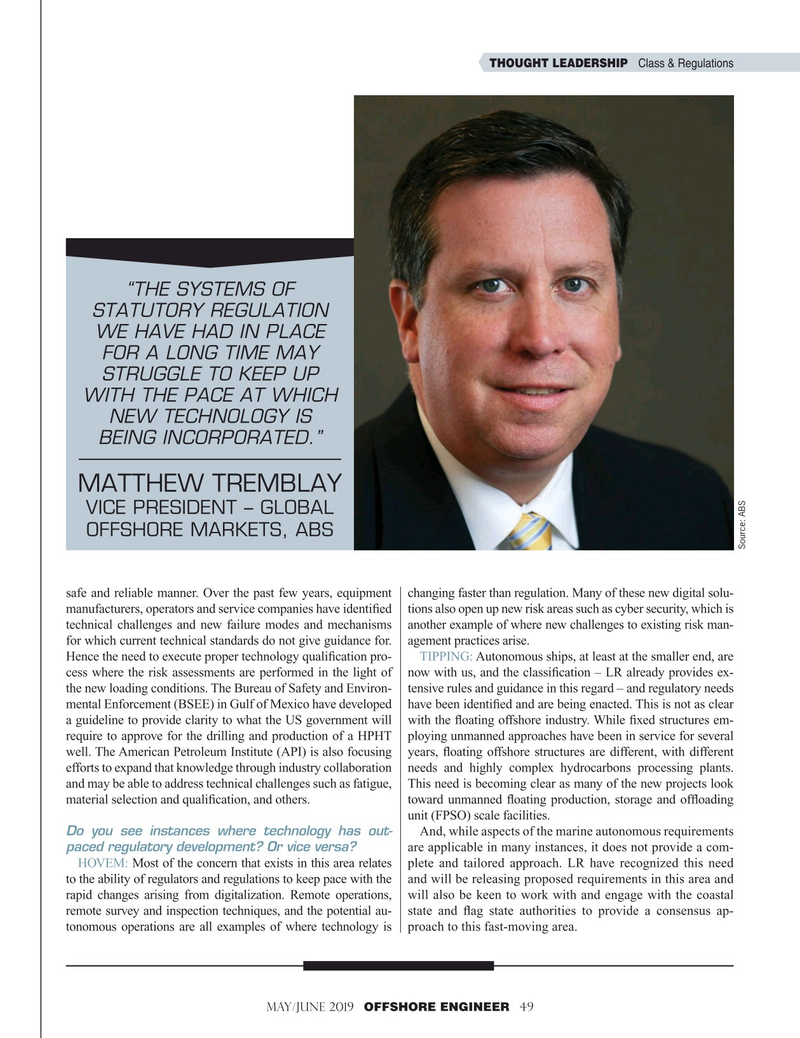
Page 49: of Offshore Engineer Magazine (May/Jun 2019)
Offshore Renewables Review
Read this page in Pdf, Flash or Html5 edition of May/Jun 2019 Offshore Engineer Magazine
THOUGHT LEADERSHIP Class & Regulations “THE SYSTEMS OF
STATUTORY REGULATION
WE HAVE HAD IN PLACE
FOR A LONG TIME MAY
STRUGGLE TO KEEP UP
WITH THE PACE AT WHICH
NEW TECHNOLOGY IS
BEING INCORPORATED.”
MATTHEW TREMBLAY
VICE PRESIDENT – GLOBAL
OFFSHORE MARKETS, ABS
Source: ABS safe and reliable manner. Over the past few years, equipment changing faster than regulation. Many of these new digital solu- manufacturers, operators and service companies have identi? ed tions also open up new risk areas such as cyber security, which is technical challenges and new failure modes and mechanisms another example of where new challenges to existing risk man- for which current technical standards do not give guidance for. agement practices arise.
Hence the need to execute proper technology quali? cation pro- TIPPING: Autonomous ships, at least at the smaller end, are cess where the risk assessments are performed in the light of now with us, and the classi? cation – LR already provides ex- the new loading conditions. The Bureau of Safety and Environ- tensive rules and guidance in this regard – and regulatory needs mental Enforcement (BSEE) in Gulf of Mexico have developed have been identi? ed and are being enacted. This is not as clear a guideline to provide clarity to what the US government will with the ? oating offshore industry. While ? xed structures em- require to approve for the drilling and production of a HPHT ploying unmanned approaches have been in service for several well. The American Petroleum Institute (API) is also focusing years, ? oating offshore structures are different, with different efforts to expand that knowledge through industry collaboration needs and highly complex hydrocarbons processing plants. and may be able to address technical challenges such as fatigue, This need is becoming clear as many of the new projects look material selection and quali? cation, and others. toward unmanned ? oating production, storage and of? oading unit (FPSO) scale facilities.
Do you see instances where technology has out- And, while aspects of the marine autonomous requirements paced regulatory development? Or vice versa? are applicable in many instances, it does not provide a com-
HOVEM: Most of the concern that exists in this area relates plete and tailored approach. LR have recognized this need to the ability of regulators and regulations to keep pace with the and will be releasing proposed requirements in this area and rapid changes arising from digitalization. Remote operations, will also be keen to work with and engage with the coastal remote survey and inspection techniques, and the potential au- state and ? ag state authorities to provide a consensus ap- tonomous operations are all examples of where technology is proach to this fast-moving area.
MaY/JUNE 2019 OFFSHORE ENGINEER 49

 48
48

 50
50